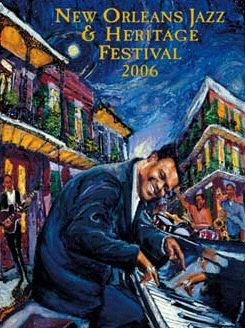 As the third anniversary of Hurricane Katrina nears, it is beneficial to search for signs of recovery and progress. What can be found is a city showing big improvements in many fields, from housing and education to business and entertainment, greening its urban neighborhoods and creating improved parks and recreation areas.
As the third anniversary of Hurricane Katrina nears, it is beneficial to search for signs of recovery and progress. What can be found is a city showing big improvements in many fields, from housing and education to business and entertainment, greening its urban neighborhoods and creating improved parks and recreation areas.
New Orleans, the city that was founded in 1718 and named for Philippe II d’Orléans, is back to 87% of its pre-storm population and, for those that stayed or returned, jobs are plentiful with an unemployment rate of only 3%. In addition to the tourist industry which has always thrived in the Big Easy, skilled jobs are available in healthcare, education and construction. Jobs in New Orleans are also paying more (e.g., post-Katrina Burger King started offering hiring bonuses of $5,000 if you work there for a year and Starbucks is paying as much as do child care centers). Urban planners predict that the need for skilled construction workers will remain strong for the next decade.
Highlights of Recovery Begin With Housing
Habitat for Humanity has become the leading homebuilder for affordable housing and one of the foremost forces of recovery in the city. Post Katrina, Habitat has built more than 100 houses and has 160 more under construction now. 60,000 volunteers have flocked to New Orleans in the past two and half years to do their part.
New Orleans native Harry Connick Jr. in collaboration with Habitat for Humanity and corporate sponsors has designed a Musician’s Village for the Ninth Ward featuring affordable housing and a music center to help musicians to be able to return to their beloved city. The project has completed 50 of the 72 homes in the village’s core and construction has begun on the project’s centerpiece — the Ellis Marsalis Center for Music — which is named for the jazz pianist and patriarch of the Marsalis family. The center will include a performance hall and practice rooms and serve as a place for musicians of different ages and genres to mingle.
Brad Pitt has led another effort for affordable housing — this time, environmentally friendly and sustainable homes to withstand the delta’s soil and weather. Global Green USA is a partner in the “Make It Right” project that sponsored an international design competition to build a “net-zero energy” house that would produce as much energy as it consumes. The community of homes, to be built in the Holy Cross neighborhood of the 9th ward for property owners there, will be greener, highly energy efficient, even including a rain screen system that allows moisture to drain from buildings and thus inhibit mold. On May 15 Global Green USA and The Home Depot Foundation celebrated the completion of the first home that will serve as a visitor center while the project, including five single-family homes, an 18 multi-unit apartment complex and a community center that includes child care, is completed.
Along with the new and rebuilt housing, the Federal Emergency Management Agency (FEMA) has been moving people out of its trailers at quite a pace – nearly 10,000 families were moved in the first quarter of 2008. That leaves just over 23,000 families still in trailers, down from a high of more than 73,000 in mid-2006.
Supporting the new neighborhood growth is a rebuilt New Orleans Police Department headquarters where repairs were finished in January, 2008 and a new sewer system with 4,660 feet of state of the art technology that works in the climate and sea level zero gravity that characterizes this metro area.
 A New Media Darling
A New Media Darling
The US media is also focusing more on the architecture and style that has historically made New Orleans an admired city. The magazine, Cottage Living, devoted its October, 2007 issue to New Orleans and built an “Idea Home” there in partnership with the nonprofit Preservation Resource Center. The house replaced a building which area residents claimed could be “blown over” it was so damaged and the rebuilt home was opened for tours and eventually sold.
The TV show “This Old House” has chronicled a rebuilding effort in New Orleans this year – featuring a 1892 Italianate-style shotgun house in the flood-ravaged Lower Ninth Ward. The homeowner is Rashida Ferdinand, a 32-year-old pre-med student on a tight budget. Old House helped Rashida build in the style of her historic neighborhood using a local architect’s design to maintained the integrity of the shotgun cottage even while doubling its size.
HGTV plans to choose families this year for a program that will help those who fell short in federal aid, insurance proceeds or other funds.
School Performance is Climbing
Prior to the Katrina storm the New Orleans area school systems were in significant trouble. Today they ate the largest US testing ground for school choice. With several Recovery Schools run by the state and only five New Orleans public schools left, Charter Schools represent 60% of schools now in the parish, and parents are hopeful.
As soon as May 2008 New Orleans had attained improved test scores for students by 12 percentage points over 2007 for fourth grade students, and by four percentage points for eighth graders. City school officials also noted significant increases in the numbers of students with passing scores in the test’s various components — English, math, science, social studies and reading.
In higher education, the interest in New Orleans colleges is strong. Loyola, Tulane and Xavier have received a higher-than expected number of enrollment deposits this spring — stronger than they were in May, 2007.
Last but certainly not least in education, overall teacher quality throughout Louisiana is improving with more entry and continuing education training requirements for teachers and more certified teachers in teaching positions. 95.7 percent of the state’s teachers were certified for the 2006-07 school year, while only 85.8% had a standard teaching certificate seven years earlier.
Business and Tourism is Booming
From a business perspective, positive progress in New Orleans is evident in the reopening of many of the famous tourist and neighborhood restaurants and the rebirth of 25 PJ’s Coffee Houses.
PJ’s, founded nearly 30 years ago in the heart of the Big Easy, grew into a chain of 42 coffeehouses located across Alabama, Florida, Louisiana, and Mississippi. All 25 New Orleans PJ’s stores suffered damage and were stymied by a crippled supply chain, but thanks to employees, loyal patrons and state troopers who frequented the shops and intervened to open roads for them, PJs has rebuilt their operations and is thriving again.
The Louisiana Restaurant Association reports 35% of the former 3,400 eating establishments have been recertified to open. Those that are open are doing well. From the French Quarter to the area near Tulane University, from the highest-end bistros to the tiniest neighborhood rice-and-bean joints, restaurants report crowds both during the week and on weekends with hours more constrained by ability to find enough workers than by a lack of paying customers. Favorite New Orleans restaurants returning in 2008 include Katies’ Barreca’s, Charlie’s Steak House and Maximo’s.

Travel programs are back, and food writers are again sampling the local fare. Fashion magazines, which, like the film industry, seemed to take a renewed interest in the area before Katrina hit in August 2005, have returned, too: W magazine, for example, used New Orleans as its backdrop for a 60-page Bruce Weber photo spread in its April, 2008 issue.
The New Orleans Jazz and Heritage Festival continues to bring some of the top names in jazz, country and all kinds of music to the area. Sports teams have returned to New Orleans. The Arena Bowl, which came to New Orleans in summer 2007 as part of the Arena Football League’s efforts to help the city recover from Hurricane Katrina, is scheduled again for summer 2008. The Sugar Bowl returned in January, 2008 attracting 74,000 fans. A week later, the Louisiana Superdome hosted the Bowl Championship Series, in February, the NBA All-Star Game, and regularly, the NBA Hornets full time, and in March, a regional round of the NCAA women’s basketball tournament.
Parks and Green Places
Efforts to beautify the city and restore its wonderful ambiance are evident in the St. Charles neighborhood and riverfront area. The city’s department of parks, along with the St. Charles Avenue Neighborhood Association, recently celebrated the planting of one hundred live Oak trees along St. Charles Avenue.
In May, a massive $289 million urban redevelopment project was approved for the riverfront area to replace decaying sections there with parks and public venues that will trigger private investment. The centerpiece of the project, known as Reinventing the Crescent, is a linear park that devotes nearly 85 percent of the development zone’s 174 acres to parks and plazas, bike and walking paths and venues for river-gazing. Signatures of the design include examples of dramatic, forward-thinking architecture as well as inventive ideas for accommodating the various industrial wharfs and terminals that must be retained for cargo and transportation uses.
When completed the riverfront project could generate some $3 billion in private investments, add 4,500 permanent jobs and increase the city’s tax revenues by $40 million a year.
As of May, 2008 the city of Orleans has 161 projects in the planning and execution stage. Their progress can be monitored on the web site neworleans.iprojweb.com.
There is still much work to be done, but the progress is clear and long term success is ensured by the spirit and determination of the people who love so much this city of New Orleans.
(Geri Weis-Corbley provided writing and editing assistance for this article)



















